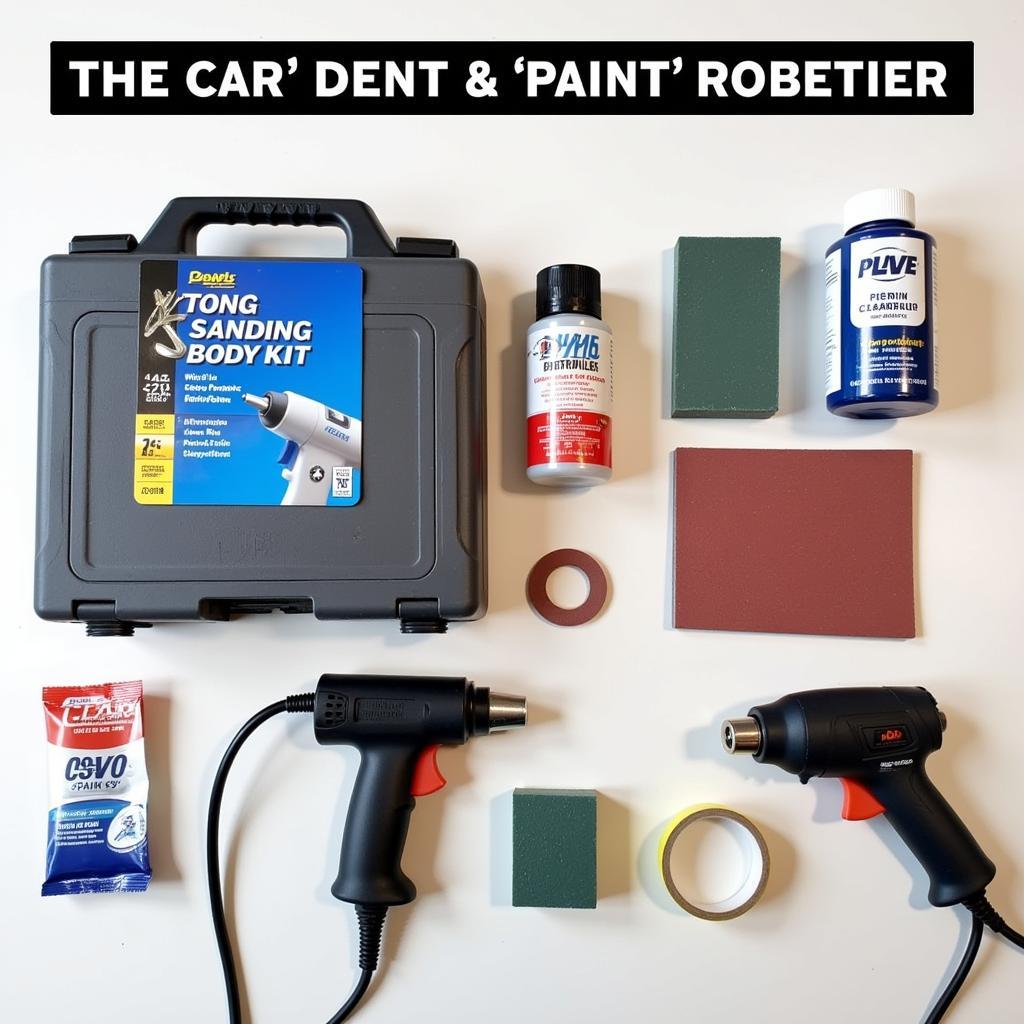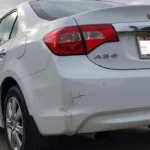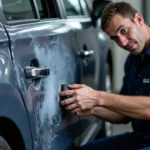Fixing a dent and repainting your car can seem daunting, but with the right knowledge and tools, it’s a manageable DIY project or something you can confidently discuss with a professional. This guide provides a comprehensive overview of how to repair a dent in a car and paint, covering everything from assessing the damage to achieving a flawless finish.
Assessing the Damage: The First Step in Car Dent and Paint Repair
Before you begin any repairs, thoroughly examine the dent. Is it a shallow ding or a deep crease? Is the paint chipped, scratched, or cracked? The extent of the damage will determine the tools and techniques required. A small, shallow dent might be fixable with a paintless dent repair (PDR) kit, while more significant damage will require traditional bodywork and repainting. Check out resources like car dent and paint repair kit for more information on DIY kits. Understanding the damage is crucial for a successful repair.
What if the previous repair wasn’t satisfactory? Sometimes, a bad paint job after a repair can be more frustrating than the original dent. Knowing how to identify and address issues like car repair paint bad job is also valuable.
Tools and Materials for Dent and Paint Repair
Gather the necessary tools and materials before starting the repair process. This will make the process smoother and more efficient. For minor dents, you might need a PDR kit, a heat gun, and some rubbing compound. For more significant damage, you’ll need body filler, sandpaper, primer, paint, clear coat, and various tools like sanding blocks, masking tape, and a spray gun or aerosol cans.
 Essential Tools and Materials for Car Dent and Paint Repair
Essential Tools and Materials for Car Dent and Paint Repair
Step-by-Step Guide: How to Repair a Dent and Paint
- Prepare the Area: Clean the damaged area thoroughly with soap and water, then degrease it with a wax and grease remover. This ensures proper adhesion of the filler and paint.
- Repairing the Dent: If using a PDR kit, follow the manufacturer’s instructions. For deeper dents, apply body filler, allow it to dry, and sand it smooth. Multiple applications and sanding might be necessary.
- Priming: Apply a thin, even coat of automotive primer to the repaired area. Primer provides a good surface for the paint to adhere to and helps to hide any imperfections.
- Painting: Once the primer is dry, apply several thin coats of automotive paint, allowing each coat to dry before applying the next. Use a high-quality automotive paint that matches your car’s color.
- Clear Coat: After the paint has dried, apply a few coats of clear coat to protect the paint and give it a glossy finish.
- Finishing Touches: Once the clear coat is dry, wet sand and buff the area to achieve a smooth, even finish. This is where your attention to detail will truly shine.
Professional Car Dent and Paint Repair: When to Call the Experts
While minor dents and scratches can be tackled at home, complex repairs are best left to professionals. If the dent is severe, involves structural damage, or you’re unsure about any step of the process, seeking professional help is wise. They have the experience and specialized tools to ensure a high-quality, long-lasting repair.
For example, if you are in Melbourne and looking for expert assistance, consider exploring options like car dent and paint repair melbourne. Getting professional help can save you time and ensure a flawless result.
DIY vs. Professional Repair: Weighing the Costs
One significant factor in deciding between DIY and professional repair is the cost. DIY can be cheaper initially, but factor in the cost of tools, materials, and your time. Professional repairs can be more expensive, especially for extensive damage. Research local car dent and paint repair price to get an idea of what to expect. For specific locations like Concord, look for resources like concord car dent and paint repair cost for a more accurate estimate.
Conclusion: Achieving a Flawless Finish with Dent and Paint Repair
Repairing a dent and repainting your car can be a rewarding experience, whether you choose the DIY route or hire a professional. By understanding the process, gathering the right tools and materials, and paying attention to detail, you can restore your car’s appearance and protect it from further damage. Knowing how to repair a dent in a car and paint empowers you to make informed decisions about your vehicle’s maintenance.
FAQ
- Can I repair a dented bumper myself?
- What type of paint should I use for car repairs?
- How long does it take for body filler to dry?
- How do I match my car’s paint color?
- Is it necessary to use a clear coat?
- Can I use a hair dryer instead of a heat gun for PDR?
- What should I do if the paint doesn’t match after the repair?
Common Dent and Paint Repair Scenarios:
- Minor Scratches and Scuffs: These can often be addressed with touch-up paint and careful polishing.
- Small Dents without Paint Damage: Paintless dent repair (PDR) is an excellent option for these.
- Dents with Paint Damage: This will require body filler, sanding, priming, and painting.
- Deep Dents with Creases: These might require more extensive bodywork and possibly even replacement of the damaged panel.
Further Exploration:
For more specific information on various aspects of car repair and maintenance, explore other helpful articles on our website.
Need Help? Contact Us!
For any assistance regarding car diagnostics and repair, feel free to reach out to our 24/7 customer support team via WhatsApp: +1(641)206-8880 or Email: [email protected].


